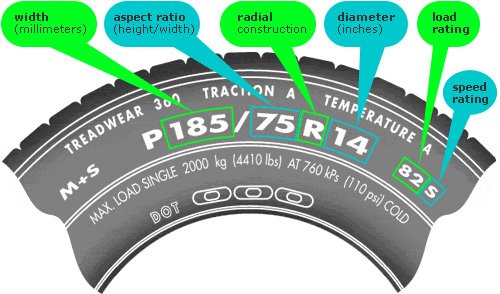Choosing the right tires is essential for safety, fuel efficiency, and driving performance. With so many options available—all-season, winter, performance, and off-road tires—it can be overwhelming. This guide will help you find the best tires for your car, SUV, or truck based on your driving habits, weather conditions, and road surfaces.
1️⃣ Know Your Vehicle’s Tire Specifications
Every vehicle has recommended tire size, load index, and speed rating specified by the manufacturer. You can find this information:
📌 On the driver’s side door jamb
📌 In the owner’s manual
📌 On the sidewall of your current tires
🔍 Understanding Tire Size Example:
If your tire reads P225/60R16 98T, here’s what it means:
- P225 – Tire width in millimeters (225mm)
- 60 – Aspect ratio (height of sidewall as a percentage of width)
- R16 – Radial tire & wheel diameter (16 inches)
- 98T – Load index & speed rating
2️⃣ Choose the Right Type of Tire for Your Driving Needs
🚗 All-Season Tires – Best for everyday driving in moderate climates. Good traction in rain and dry conditions.
❄ Winter Tires (Snow Tires) – Designed for ice, snow, and freezing temperatures. Provide superior grip but wear faster on dry roads.
🏁 Performance Tires – Built for high-speed handling and cornering. Ideal for sports cars but may have reduced tread life.
🌧 All-Terrain & Off-Road Tires – Ideal for trucks & SUVs that frequently drive on dirt, gravel, or uneven terrain.
3️⃣ Consider Tread Patterns for Maximum Performance
The tread pattern affects traction, handling, and road noise.
✅ Symmetrical Tread: Longer lifespan, smooth ride, lower rolling resistance.
✅ Asymmetrical Tread: Great for performance vehicles, improved cornering.
✅ Directional Tread: Best for wet weather & snow, helps prevent hydroplaning.
4️⃣ Look at Tire Ratings for Safety & Durability
✔ Traction Rating: Indicates stopping performance on wet roads (rated AA, A, B, C).
✔ Treadwear Rating: Measures how long the tire should last (higher numbers = longer lifespan).
✔ Temperature Rating: Shows how well the tire resists heat buildup (rated A, B, or C).
5️⃣ When to Replace Your Tires
🚨 Signs You Need New Tires:
- Tread Depth is Below 2/32″ (Use the penny test—if you see Lincoln’s head, replace your tires!)
- Cracks, Bulges, or Uneven Wear
- Frequent Loss of Air Pressure
- Increased Road Noise or Poor Handling
💡 Tip: Rotating your tires every 5,000–8,000 miles extends their lifespan!
Need New Tires? Visit Onsite Auto Services!
🚗 Looking for the best tires for your vehicle? At Onsite Auto Services, we offer professional tire selection, installation, wheel balancing, and alignment services to ensure a smooth and safe ride.
📞 Call us today or schedule an appointment online for expert tire recommendations & installation!
“Need new tires? Learn how to choose the best tires for your vehicle based on driving conditions, tread patterns, and performance needs. Read our expert guide!”
#TireGuide #NewTires #AllSeasonTires #WinterTires #AutoRepair #CarMaintenance #TireShopping #VehicleSafety #CarTires #TireReplacement

